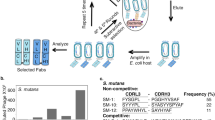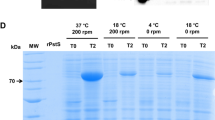Abstract
Dental decay is a major public health challenge, causing substantial social and economic burdens. In animals, vaccination against mutans streptococci, the causative organism, interferes with dental caries. The mutans streptococcal glucosyltransferase (GTF) has been effectively used as a protein antigen in experimental dental caries vaccines. Compared to whole proteins, peptide subunits can focus immune responses on protective epitopes, and not on potentially harmful cross reactive antigens. In the past we selected peptide subunits of GTF for vaccine discovery based on putative functional significance and conservation of GTF primary structure. To focus on the immunogenicity of peptides, we estimated the probability of MHC class II binding. Twenty 20-mer linear GTF peptides were synthesized on this basis and their immunoreactivity explored. Significant human peripheral blood mononuclear cell (PBMC; n = 12) proliferation was observed in response to amino acids (AA) 502–521 (peptide 7), located in the catalytic domain of GTF. Human serum (n = 36) antibody reactivity was observed to AA 438–457 (peptide 5), AA 502–521 (peptide 7), and AA 1376–1395 (peptide 16). Whole saliva mutans streptococcal levels were used as markers of mutans infection, and dental examinations to determine existing and historic caries (DMFS score) were performed. DMFS scores correlated with mutans streptococcal counts, but not with immune responses. We have identified peptides with projected avid MHC-binding activity that reacted with human PBMC and serum antibody, implying that these peptides are immunogenic and may be of significance in a subunit dental caries vaccine.


Similar content being viewed by others
References
Challacombe SJ, Russell MW, Hawkes J (1978) Passage of intact IgG from plasma to the oral cavity via crevicular fluid. Clin Exp Immunol 34(3):417–422
Chia JS, Lin RH, Lin SW, Chen JY, Yang CS (1993) Inhibition of glucosyltransferase activities of Streptococcus mutans by a monoclonal antibody to a subsequence peptide. Infect Immun 61(11):4689–4695
Culshaw S, LaRosa K, Tolani H, Han X, Eastcott JW, DJ Smith DJ, MA Taubman MA (2007) Immunogenic and protective potential of mutans streptococcal glucosyltransferase peptide constructs selected by major histocompatibility complex class II allele binding. Infect Immun 75(2):915–923
Durack DT, Gilliland sBC Petersdorf RG (1978) Effect of immunization on susceptibility to experimental Streptococcus mutans and Streptococcus sanguis endocarditis. Infect Immun 22(1):52–56
Gabris K, Nagy G, Madlena M, Denes Z, Marton S, Keszthelyi G, Banoczy J (1999) Associations between microbiological and salivary caries activity tests and caries experience in Hungarian adolescents. Caries Res 33(3):191–195
Gold OG, Jordan HV, van Houte J (1973) A selective medium for Streptococcus mutans. Arch Oral Biol 18:1357–1364
Hamada S, Slade HD (1980) Biology, immunology, and cariogenicity of Streptococcus mutans. Microbiol Rev 44(2):331–384
Kaste LM, Selwitz RH, Oldakowski RJ, Brunelle JA, Winn DM, Brown LJ (1996) Coronal caries in the primary and permanent dentition of children and adolescents 1–17 years of age: United States, 1988–1991. J Dent Res 75 Spec No:631–641
Laloi P, Munro CL, Jones KR, Macrina FL (1996) Immunologic characteristics of a Streptococcus mutans glucosyltransferase B sucrose-binding site peptide-cholera toxin B-subunit chimeric protein. Infect Immun 64(1):28–36
Lehner T, Challacombe SJ, Wilton JM, Caldwell J (1976) Cellular and humoral immune responses in vaccination against dental caries in monkeys. Nature 264(5581):69–72
Loesche WJ (1986) Role of Streptococcus mutans in human dental decay. Microbiol Rev 50(4):353–380
McGhee JR, Michalek SM, Webb J, Navia JM, Rahman AF, Legler DW (1975) Effective immunity to dentaI caries: Protection of gnotobiotic rats by local immunization with Streptococcus rnutans. J Immunol 16:300–305
Monchois V, Lakey JH, Russell RR (1999) Secondary structure of Streptococcus downei GTF- I glucansucrase. FEMS Microbiol Lett 177(2):243–248
Mooser G, Wong C (1988) Isolation of a glucan-binding domain of glucosyltransferase (1,6-alpha-glucan synthase) from Streptococcus sobrinus. Infect Immun 56(4):880–884
Mylonakis E, Calderwood SB (2001) Infective endocarditis in adults. N Engl J Med 345(18):1318–1330
Palmer NO, Martin MV, Pealing R, Ireland RS (2000) An analysis of antibiotic prescriptions from general dental practitioners in England. J Antimicrob Chemother 46(6):1033–1035
Petersen P (2003) The World Oral Health Report 2003, World Health Organization, Geneva
Pitts NB, Chestnutt IG, Evans D, White D, Chadwick B, Steele JG (2006) The dentinal caries experience of children in the United Kingdom, 2003. Br Dent J 200(6):313–320
Roberts CG, Meister GE, Jesdale BM, Lieberman J, Berzofsky JA, De Groot AS (1996) Prediction of HIV peptide 4 epitopes by a novel algorithm. AIDS Res Hum Retrov 12(7):593–610
Robinson J, Waller MJ, Parham P, Bodmer JG, Marsh SG (2001) IMGT/HLA Database-a sequence database for the human major histocompatibility complex. Nucleic Acids Res 29(1):210–213
Robinson J, Waller MJ, Parham P, de Groot N, Bontrop R, Kennedy LJ, Stoehr P, Marsh SG (2003) IMGT/HLA and IMGT/MHC: sequence databases for the study of the major histocompatibility complex. Nucleic Acids Res 31(1):311–314
Singh H, Raghava GP (2001) ProPred: prediction of HLA-DR binding sites. Bioinformatics 17(12):1236–1237
Smith DJ, Heschel RL, King WF, Taubman MA (1999) Antibody to glucosyltransferase induced by synthetic peptides associated with catalytic regions of alpha-amylases. Infect Immun 67(5):2638–2642
Smith DJ, King WF, Rivero J, Taubman MA (2005) Immunological and protective effects of diepitopic subunit dental caries vaccines. Infect Immun 73(5):2797–2804
Smith DJ, Shoushtari B, Heschel RL, King WF, Taubman MA (1997) Immunogenicity and protective immunity induced by synthetic peptides associated with a catalytic subdomain of mutans group streptococcal glucosyltransferase. Infect Immun 65(11):4424–4430
Smith DJ, Taubman MA (1976) Immunization Experiments Using the Rodent Caries Model. J Dent Res 55 Spec No:C193–C205
Smith DJ, Taubman MA, Holmberg CF, Eastcott JW, King WF, Ali-Salaam P (1993) Antigenicity and immunogenicity of a synthetic peptide derived from a glucan-binding domain of mutans streptococcal glucosyltransferase. Infect Immun 61(7):2899–2905
Smith DJ, Taubman MA, King WF, Eida S, Powell JR, Eastcott JW (1994) Immunological characteristics of a synthetic peptide associated with a catalytic domain of mutans streptococcal glucosyltransferase. Infect Immun 62(12):5470–5476
Tam JP (1988) Synthetic peptide vaccine design: synthesis and properties of a high-density multiple antigenic peptide system. Proc Natl Acad Sci U S A 85(15):5409–5413
Taubman MA, Holmberg CJ, Smith DJ (1995) Immunization of rats with synthetic peptide constructs from the glucan-binding or catalytic region of mutans streptococcal glucosyltransferase protects against dental caries. Infect Immun 63(8):3088–3093
Taubman MA, Holmberg CJ, Smith DJ (2001) Diepitopic construct of functionally and epitopically complementary peptides enhances immunogenicity, reactivity with glucosyltransferase, and protection from dental caries. Infect Immun 69(7):4210–4216
Taubman MA, Nash D (2006) The scientific and public-health imperative for a vaccine against dental caries. Nature Rev Immunol 6(7):555–563
Taubman MA, Smith DJ (1974) Effects of local immunization with Streptococcus mutans on induction of salivary immunoglobulin A antibody experimental dental caries in rats. Infect Immun 9:1079–1091
Taubman MA, Smith DJ (1977) Effects of local immunization with glucosyltransferase fractions from Streptococcus mutans on dental caries in rats and hamsters. J Immunol 118(2):710–720
Taubman MA, Smith DJ, Holmberg CJ, Eastcott JW (2000) Coimmunization with complementary glucosyltransferase peptides results in enhanced immunogenicity and protection against dental caries. Infect Immun 68(5):2698–2703
Tsumori H, Minami T, Kuramitsu HK (1997) Identification of essential amino acids in the Streptococcus rnutans glucosyltransferase. J Bacteriol 179(11):3391–3396
Acknowledgements
This work was supported by NIH grant DE-04733 from the National Institute of Dental and Craniofacial Research. The authors are grateful to Dr. Mary Tavares, Forsyth Institute, Boston, who kindly performed dental examinations, to Dr. Toshi Kawai for provision of phlebotomy expertise, and to Mr. William King for measurement of salivary IgA antibody to the MAP peptides.
Author information
Authors and Affiliations
Corresponding author
Rights and permissions
About this article
Cite this article
Culshaw, S., Han, X., La Rosa, K. et al. Assessment of Human Immune Response to Mutans Streptococcal Glucosyltransferase Peptides Selected by MHC Class II Binding Probability. Int J Pept Res Ther 13, 525–531 (2007). https://doi.org/10.1007/s10989-007-9110-3
Received:
Accepted:
Published:
Issue Date:
DOI: https://doi.org/10.1007/s10989-007-9110-3




